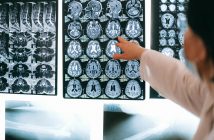
Urinary incontinence is any uncontrollable loss of urine. It can affect all ages.
The severity of urinary incontinence ranges from occasionally leaking urine when you cough, sneeze, or even laugh, to having an urge to urinate that is so sudden and strong you don’t get to a toilet in time. This common and embarrassing problem should not have to restrict your day-to-day activities and affect your quality of life.
Types of urinary incontinence
- Most bladder control problems happen when muscles are too weak or too active. If muscles that keep the bladder closed are too weak, you may have an “accident” when you sneeze, cough, laugh, or lift heavy objects. This is called stress incontinence, which accounts for about 80 percent of cases.
- If bladder muscles become too active, on the other hand, you may feel a sudden and strong urge to urinate, followed by an involuntary loss of urine, leaving only a few seconds to reach the bathroom. This is called urge incontinence or overactive bladder, which accounts for about 15 percent of cases.
- If you frequently or constantly dribble urine, you may have overflow incontinence, which is an inability to empty your bladder. Sometimes, you may feel as if you never completely empty your bladder. When you try to urinate, you may produce only a weak stream of urine.
- Mixed incontinence is if you experience symptoms of more than one type of urinary incontinence. These forms are more frequent in older women. Other, more complex forms are rare.
Causes of temporary urinary incontinence
Certain foods, drinks, and medications can cause temporary urinary incontinence. A simple change in habits can bring relief.
- Alcohol and caffeine: Both of these substances act as a bladder stimulants and diuretics, which can cause an urgent need to urinate.
- Bladder irritation: Carbonated drinks, tea, and coffee – with or without caffeine – artificial sweeteners, corn syrup, and foods and beverages that are high in spice, sugar and acid(such as citrus and tomatoes), can aggravate your bladder.
- Medication: Heart medication, blood pressure drugs, sedatives, muscle relaxants, and other medications may contribute to bladder control problems.
- Urinary tract infections: Infections can irritate your bladder, causing you to have strong urges to urinate. These urges may result in episodes of incontinence, which may be your only warning sign of a urinary tract infection.
- Constipation: The rectum is located near the bladder and shares many of the same nerves. Hard, compacted stool in your rectum can cause these nerves to be overactive and increase urinary frequency.
Causes of persistent urinary incontinence
Urinary incontinence can also be a persistent condition caused by underlying physical problems or changes, including:
- Pregnancy and childbirth: Pregnant women may experience stress incontinence because of hormonal changes and the increased weight of an enlarging uterus. As recent studies have shown, it is less a result of the method of birth (C-Section or vaginal birth) than pregnancy itself, which is responsible for postpartum incontinence. The changes that occur during pregnancy can also damage bladder nerves and supportive tissue, leading to a dropped (prolapsed) pelvic floor. With a prolapsed pelvic floor, your bladder, uterus, rectum or small bowel can be pushed down from their normal position and protrude into the vagina. Such protrusions can be associated with incontinence.
- Changes with aging: Aging of the bladder muscles leads to a decrease in the bladder’s capacity to store urine and an increase in overactive bladder symptoms. Risk of overactive bladder increases if you have blood vessel disease, so maintaining good overall health – including stopping smoking, treating high blood pressure, and keeping your weight within a healthy range – can help curb symptoms of an overactive bladder. After menopause, women produce less estrogen, a hormone that helps keep the lining of the bladder and urethra healthy. With less estrogen, these tissues may deteriorate, which can induce and even aggravate incontinence.
Complications
- Skin problems: Urinary incontinence can lead to rashes, skin infections, and sores (skin ulcers) from constantly wet skin.
- Urinary tract infections: Incontinence increases your risk of repeated urinary tract infections.
- Changes in your activities: Urinary incontinence may keep you from participating in normal activities. You may stop exercising, quit attending social gatherings, or even stop venturing away from familiar areas where you know the locations of toilets.
- Changes in your work life: Urinary incontinence may negatively affect your work life. Your urge to urinate may cause you to have to get up often during meetings. The problem may disrupt your concentration at work or keep you awake at night, causing fatigue.
- Changes in your personal life: Perhaps most distressing is the impact that incontinence can have on your personal life. Your family may not understand your behavior or grow frustrated at your many trips to the toilet. You may avoid sexual intimacy because of embarrassment caused by urine leakage. Frequently, incontinence even leads to anxiety and depression.
Diagnosis
Diagnosis is usually simple and quick, based on a detailed history and clinical examination with stress test, supported by a urinalysis to check for signs of infection, traces of blood, or other abnormalities. Typically, only 10 to 15 percent of cases require further information, which may require the patient to undergo additional testing, including:
- Postvoid residual (PVR) measurement: For this procedure, the patient is asked to urinateinto a container that measures urine output. The doctor then checks the amount of leftover urine in the bladder using a catheter or ultrasound test. A large amount of leftover urine in the bladder may mean that there isan obstruction in theurinary tract or a problem with thebladder nerves or muscles.
- Urodynamic testing: These tests measure pressure in the bladder when it is at rest and when it is filling up. A doctor or nurse inserts a catheter into the urethra and bladder to fill the bladder with water. Meanwhile, a pressure monitor measures and records the pressure within the bladder. This test measures bladder strength and urinary sphincter health, and is an important tool for determining the type of incontinence the patient has.
- Cystoscopy: A thin tube with a tiny lens (cystoscope) is inserted into the urethra. During cystoscopy, the doctor can check for abnormalities in the bladder.
- Electromyogram (EMG): An examination to measure the electric activity of a muscle or nerve to look for neurological damage.
Treatment
Treatment for urinary incontinence depends on the type of incontinence, its severity, and the underlying cause, though there are some general rules to follow:
Temporary incontinence can usually be treated by simple means like behavioral changes (beverage, food and medication) or the treatment of underlying infections and deficiency in estrogen. Urge incontinence is treated by medication – there is no place for surgery. Stress incontinence is the domain of surgery.
There are various programs of bladder training and pelvic floor muscles exercises, all more or less long and binding, which may improve your condition. Unfortunately, the healing rate is very low and even good results do not last forever. To propose “scheduled toilet trips” or “fluid and diet management” doesn’t fit with an active lifestyle.
Pessaries – a stiff ring or cube inserted into the vagina and worn throughout the day – were frequently prescribed in the past, but are now considered to be outdated. Pads and garments are also available as alternatives, but can this be a satisfying long-term solution?
Considerable progress in surgical techniques has been made in recent years, which have completely changed the attitudes of all doctors concerned about female urinary incontinence.
These techniques, called TVT/TOT (tension free vaginal tape), are now available in Beijing. They consist of placing a tape just underneath the urethra to support the neck of the bladder during an increase of pressure (coughing, sneezing, exercise, and more). This operation takes less than 30 minutes, hasextremely high long-term efficiency, and benefits from a very low rate of complication. Although frequently performed as an outpatient procedure, the patient may also elect to spend a night in hospital, which can improve the results.
The patient is fully mobile and can resume most activity after three days, and able to perform all types of physical activity after ten. This technique can also be easily combined with more complex prolapsed surgery.
More than 5 million TVOT/TOT procedures have been preformed worldwide and the overall reaction of the patient is always the same: “Oh, I should have done this earlier”.
So don’t wait, make your incontinence appointment today!
Dr. Stefan Schneyer is head of the OB/GYN department at OASIS Healthcare. Born in Bavaria, Germany, Dr. Schneyer received his medical degree from Maximillian University in Wurzburg. He completed his internship and residency in France and Germany, and his post-graduate degree in Strasbourg, France. Dr. Schneyer speaks fluent English, German, and French. His specialties include incontinence surgery and pelvic floor disorder surgery.



